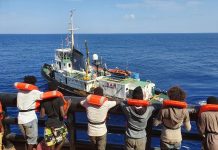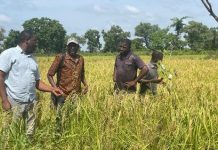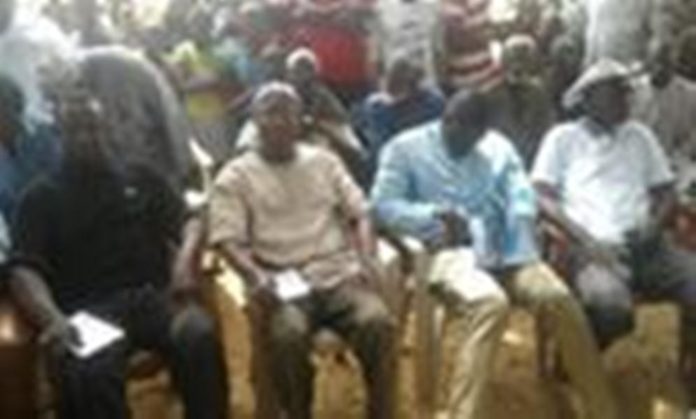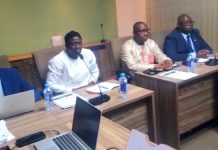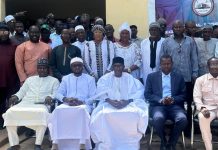By Awa B. Bah
The National Assembly (NA) select committee on the environment, Non-Governmental Organizations (NGOs) and NA committee on sustainable development, Thursday June 7th 2018, continued with the second leg of their tour of the West Coast Region, by visiting mining and environmental disaster hot spots. As part of its mandate, the NA select committee on the environment is assigned to assess environmental challenges and make recommendations to the Government.
The purpose of their visit is a fact finding one and the communities visited include Faraba Banta village, to assess the damage done by mining Companies and local individuals to their environment and farmlands, as adduced to by villagers. The villagers of Faraba gathered at the village square, where the meeting was held.
After the usual brief welcome and introductory ceremony by the Village Development Committee (VDC), Chairman Alhagie Sanyang, villagers were informed of the purpose of the visit of the NA committee to see for themselves, the mining sites on behalf of Government.
Sainey Touray, the Member for Jarra East who doubles as the Chairman of the NA select committee, informed villagers that they were not there to meet them for a discussion, but on a fact finding mission to ascertain their claim, after hearing from both parties, the villagers, the local mining Company and the Geology department.
The Alkalo of the village who was supposed to lead the delegation of the NA select committee, was nowhere to be seen when asked by the members. According to the villagers, the Alkalo has left the village for the moment because he has not been in agreement with them on the environment and mining issue at hand. The members of the NA select committee noted that the presence and role of the Alkalo in this matter, is very crucial; that it was him that the miners dealt with directly and serves as the entry point for whoever wants to do something in the village. Murmuring can be heard within the gathering of villagers, when comments on the Alkalo’s absence was mentioned.
The NA select committee was later escorted to the mining site by the villagers. The first site visited was ‘Kayaring’ swamp, a massive rice growing area for the women of the village. Big hole filled with mud and clay can be seen scattered all over the rice field. According to the women, the rice field serves as the bread basket of the village in terms of rice production; that it is the source of income of villagers and that sixty percent of the village rice, is produced from this swamp. The villagers said Swami India and Mouhtara Holdings were the Companies extracting the raw materials of fire bricks, from the area, without any benefit to the village; that their mining activity has dilapidated the rice field to the extent that salt intrusion has taken over a vast area. Villagers lament that that the rice fields are all dry now because runoff water from the rain, cannot flow to the rice field because of the big gaping holes; that instead, the runoff water from the rain flows into the village, causing floods and destruction of property.
From the rice field, the committee proceeded to the gravel mining site where heaps of already mined gravel and sand, filled the area. According to the villagers, the sand and gravel mining site was rich with fruit trees of all sort including cashew. Villagers lamented that the area should have been rehabilitate and restored to the original position it was found; that monies for rehabilitating the areas have been collected but cannot be traced; that rehabilitation fees are collected by Government through Hage Group International; that the Geology department uses the Hage Group to collect revenues; that being a Government institution, they should not allow a private Company to operate and collect duties on their behalf.
Another rice field called “Kesekereh”, was visited where mounds of sand could be seen all over the field. According to villagers, the rice field is used as their source of income to be able to take care of their families; that they used to harvest rice twice from this field because water was flow is abundant throughout the season; but that now, every side of the waterway is blocked by mounds of sand and gravel. They expressed total dissatisfaction with mining activities going on there and called on the authorities to put a halt to the environmental damage this is causing.
A newly cultivated rice field was visited, where an access road is made ready for the heavy machines of a Company called ‘Julakay.’ At the entrance of the rice field, the PIU mounts tight security. This according to them was meant to avoid a clash between the villagers and the miners. According to the villagers, eighteen Mahogany trees were cut down by the Alkalo with the mining Company and the rice field is said to be identified and allocated by Government, to ‘Julakay’ Company; that 8.1 hectares of the rice field called Sanka Nya Giboro, is being allocated to ‘Julakay’ Company for his mining operations; that they are warned by the PIU, that the rice field is a no go area for them. They called on the authorities to intervene and protect their rice fields and their environment.

The committee also visited the Brikama Market, the third largest and busiest market in the country and in the West Coast Region.
Sainey Touray, Chairman of the select committee and member for

Jarra, led the delegation. Ansu Nyass Bojang, the Councillor for Nyambai Ward and Chairman of the Brikama Market committee, guided Members on the status of the market in general and the deteriorating condition of the toilets and the fish market.
During their inspection, the NAMs visited the abandoned public toilets that was turned to a dumpsite with waste generated from the market. According to the market official, the toilets have been abandoned for the past three years now, resulting in the area being turned to an illegal dumpsite; that there are plans to rehabilitate the toilets and the reason why they were working to remove the waste.
On the fish market, the market official said if the necessary action is not taken, it will be impossible for people to buy and sell in the area, because the gutters are all full to capacity and there is no access for the water and other wastes to flow out.
The Market official said there are no plans for the fish market, and they are only working on the rehabilitation of the toilet as at now. They said the market cannot accommodate all who want to do business and this results in some vendors using the high ways, making movement of goods and services difficult.
Most of the vendors at the market who spoke to this report, lament their dissatisfaction with the Brikama Area Council. They accuse the Council of collecting revenue for their own pockets; that they suffer in the hands of the Council when it comes to the collection of daily market duties; that Council always collects daily market duties and keep chasing them in and out of the market. The vendors complained that their goods are most often confiscated and taken to their offices, if they fail to pay their daily market duties. They called on Government to look into the revenues collected by the Brikama Area Council noting that the amount of revenues that they collect daily, is huge.
Members of the select committee assured that the issues raised will be tabled before the National Assembly and Government for consideration.

